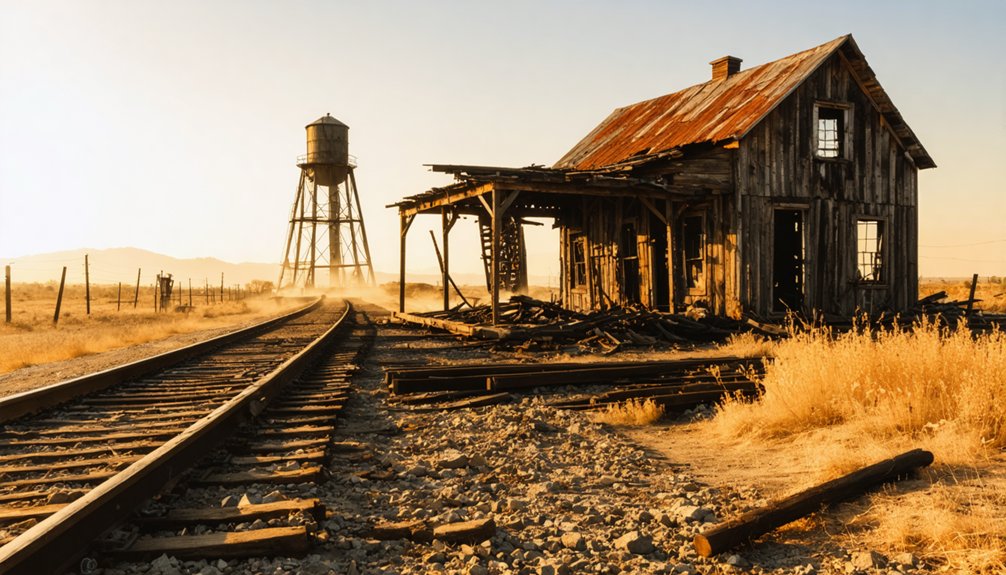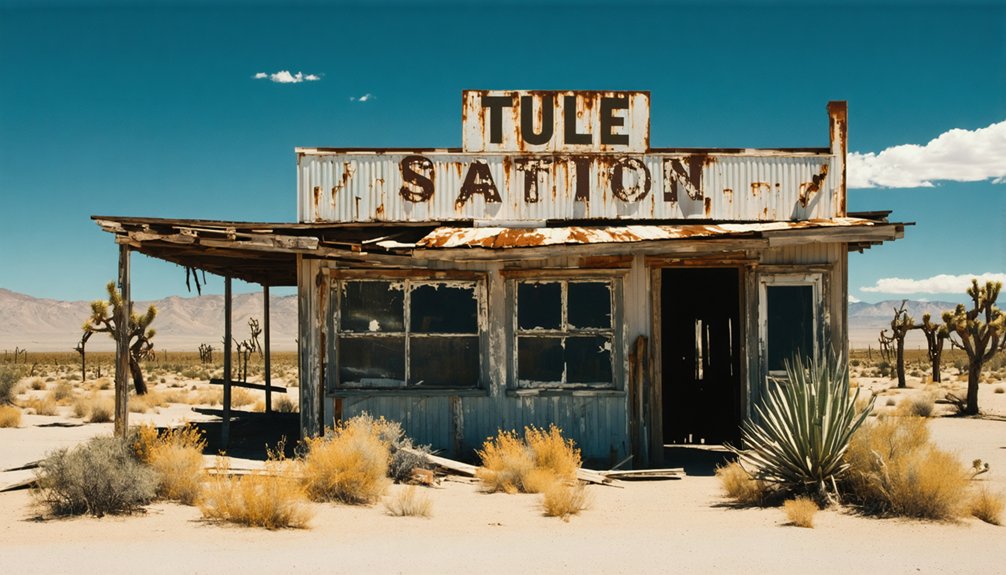Tule Station emerged in mid-1850s California as an essential Butterfield Overland Mail stop along the Stockton-Los Angeles Road. You’d have found this San Joaquin Valley waypoint bustling with Gold Rush travelers exchanging horses, sharing meals, and swapping stories. Dense tule reeds surrounded the adobe structures while stagecoaches navigated seasonal flooding. By the 1870s, railroad expansion rendered it obsolete, leaving only crumbling walls to whisper tales of California’s pioneering spirit.
Key Takeaways
- Tule Station operated as a vital Butterfield Overland Mail stop along emigrant trails in California’s San Joaquin Valley from 1854 to 1862.
- Originally managed by Peter Goodhue and later R. Porter Putnam, it served travelers on the Stockton-Los Angeles Road during the Gold Rush era.
- The station’s significance declined with railroad expansion in the 1870s, leading to its abandonment and eventual ghost town status.
- Surrounding tule wetlands created challenging environmental conditions with seasonal flooding that transformed trails into treacherous waterways.
- Today, scattered remnants of Tule Station preserve insights into pioneer life and represent Tulare County’s boom-and-bust settlement pattern.
Origins and Establishment of a Stagecoach Waypoint
As the rushing waters of the Tule River carved their path through California’s San Joaquin Valley in the mid-1850s, they witnessed the birth of a modest yet significant waypoint that would forever mark the region’s history.
From 1854 to 1862, Tule Station emerged as a vital stop along bustling emigrant trails before nature altered the river’s course.
The station’s historical significance skyrocketed in 1858 when John Butterfield, having secured a government mail contract the previous year, designated it an official Butterfield Overland Mail station.
You’d have found this strategic outpost bustling with activity as stagecoaches arrived around the clock, maintaining the strict 25-day schedule from St. Louis to San Francisco that revolutionized cross-continental communication and travel.
Travelers passing through often endured a cramped journey, with barely enough room to stretch and limited opportunity to stay clean during the harsh travel experience that defined stagecoach transportation in the American West.
The station was initially operated by Peter Goodhue before R. Porter Putnam took over management in 1860.
Life Along the Stockton-Los Angeles Road
You’d hear tales of weary travelers passing through Tule Station, their stagecoaches kicking up dust along the Stockton-Los Angeles Road as they sought refuge from the harsh valley conditions.
These essential relay points served as lifelines between northern gold country and southern settlements, where exhausted horses were exchanged for fresh teams and passengers could find a meal and brief respite from their bone-jarring journey. The road became a vital route after the Kern River Gold Rush of 1853, strategically positioned to avoid flooding in the San Joaquin Valley. The Stockton-Los Angeles Road followed the historic path through Old Tejon Pass, which had been used for generations before modern highways were constructed.
At night, the glow of oil lamps would illuminate the station’s humble quarters, where travelers from different worlds temporarily converged—miners, merchants, and mail carriers—each carrying stories that stitched together California’s expanding frontier.
Stagecoach Tales Unfold
While stagecoaches rumbled along the dusty Stockton-Los Angeles Road in the mid-19th century, Tule Station emerged as an important outpost in a network that connected California’s growing communities.
Every 10-15 miles along this vital thoroughfare, stations like Tule provided fresh horses and brief respite for weary travelers traversing the challenging terrain.
You’d have witnessed stagecoach legends unfold as drivers skillfully maneuvered winding foothill paths, avoiding the flood-prone Tule Marshes.
Historical narratives tell of passengers braving seasonal weather, bandit threats, and treacherous river crossings without bridges.
The road was established in 1853 to facilitate travel to the Kern River Gold Rush mining claims.
The road’s significance gradually diminished as railroads expanded in the 1870s, offering faster transportation through the San Joaquin Valley.
Though the stagecoaches eventually fell silent, their routes influenced modern highways like US 99 and ultimately Interstate 5.
This older thoroughfare was eventually supplanted by the Old Ridge Route, which was constructed in 1915 as a more direct route connecting Los Angeles to the north.
Relay Points Between Worlds
The Stockton-Los Angeles Road emerged as California’s lifeline in the aftermath of the 1853 Kern River Gold Rush, replacing the older El Camino Viejo with a more practical route.
Hugging the Sierra Nevada foothills, this path cleverly avoided the treacherous Tule Marshes that once swallowed unwary travelers whole.
You’d find yourself stopping at significant relay points like Bates Station, where road-weary travelers exchanged exhausted horses for fresh ones.
These historical landmarks weren’t merely functional stops—they represented cultural significance as crossroads where information, mail, and human stories intermingled.
Hensley Road, named after gold rush settler John Jackson Hensley, marked another essential waypoint along this freedom trail.
The Tule Wetlands: Natural Environment and Challenges
Standing tall along the riverbanks, dense tule reeds created a natural ecosystem that sheltered countless species of birds and small mammals you’d encounter on your journey through the station grounds.
You’d witness the dramatic transformation of the landscape during winter months, when seasonal flooding turned passable trails into treacherous waterways that isolated the station for weeks.
Your travels through these wetlands required vigilance against wildlife encounters, from harmless waterfowl to the occasional tule elk or coyote patrolling the marshland’s edge. The tules served critical ecological functions by stabilizing riverbanks and filtering sediments, improving water quality throughout the region. Before colonization and development, these wetland ecosystems covered vastly more territory throughout California, providing essential habitat and resources for indigenous communities.
Reeds and River Ecosystem
Towering gracefully amid California’s historic waterways, tule reeds once defined the landscape surrounding Tule Station, creating a vibrant ecosystem that supported countless species.
These native bulrushes, reaching heights up to ten feet, formed the backbone of the region’s tule ecology, their round green stems and brownish flower clusters swaying with river dynamics.
You’d find red-winged blackbirds nesting among the dense stands while reptiles, amphibians, and fish sought sanctuary below.
The reeds performed essential services—filtering water, preventing erosion, and sequestering carbon.
Indigenous peoples recognized their value, crafting boats and shelters from these versatile plants, embodying a relationship with the wetlands that predated colonial presence.
Modern wetland management has overlooked the valuable Traditional Ecological Knowledge that Indigenous communities developed through generations of stewardship.
Today’s restoration projects like Tule Red honor this legacy, reconnecting the ghost town’s history to the living landscape that sustained it. The Tule Red Tidal Restoration Project has successfully transformed 420 acres of marsh in Grizzly Bay, creating crucial habitat for endangered species like Delta Smelt.
Seasonal Flooding Hazards
While appearing tranquil during summer months, Tule Station’s wetlands transformed dramatically with seasonal flooding that shaped both the natural ecosystem and human settlement patterns.
You’d witness overbank flooding from the Sacramento and San Joaquin rivers creating dynamic mosaics of tule marshes and willow thickets across the landscape.
Modern flood management has greatly altered these natural regimes. Levees and agricultural conversion have reduced landscape permeability, disrupting the slow spring drawdowns essential for ideal seed production.
The timing shift of peak flows—now occurring earlier due to premature snowmelt—has decreased late-season water availability by nearly a quarter century over the past century.
Today’s wetland restoration efforts attempt to mimic natural flooding cycles through controlled irrigation, balancing habitat needs with flood hazard reduction while fighting the constant challenges of drought and altered hydrology.
Wetland Wildlife Encounters
When you explore the tule wetlands today, you’ll encounter one of California’s most diverse ecosystems, where the intricate relationship between native plants and wildlife creates a vibrant tapestry of life.
Dense stands of cattails and tules provide critical habitat for red-winged blackbirds and marsh wrens, offering ideal wildlife observation opportunities.
For excellent birdwatching tips, visit during migration seasons when greater white-fronted, snow, Ross’s, and cackling geese transform the sky into living art.
Bring binoculars to spot the majestic tule elk, once nearly extinct but now thriving in these preserved wetlands. Patient observers might glimpse endangered Lost River suckers or shortnose suckers in clearer waters.
The wetlands also host over 500 bald eagles between November and April, making dawn and dusk the perfect times for unforgettable wildlife encounters in this resilient ecosystem.
Transportation Hub in Gold Rush Era California

During the feverish days of the Gold Rush, Tule Station emerged as a significant transportation nexus in California’s expanding frontier network.
You’d find this Kern County outpost bustling with activity as stagecoaches from the Butterfield Overland Mail line arrived and departed, connecting northern mining regions with Los Angeles and beyond.
The station’s transportation innovations transformed isolated mining camps into connected communities.
Fresh horses awaited tired teams, while passengers rested before continuing their dusty journeys.
You could witness the economic impact firsthand—mail exchanged, mining equipment unloaded, and supplies transferred from stagecoaches to wagons bound for remote diggings.
This essential link in California’s communication system lasted until railroad expansion rendered stagecoaches obsolete, but not before Tule Station had cemented its place in the state’s development.
Vanishing Into History: The Decline of Tule Station
After the railroad barons stretched their iron tentacles across California in the 1870s, Tule Station‘s importance began to wither like sage in summer heat.
The once-bustling waypoint found itself bypassed by progress, its lifeblood of travelers and commerce diverted to steel rails miles away. You can still sense the ghostly echoes of what once was when you walk these forgotten grounds.
- Standing among crumbling adobe walls, you’ll feel the whispered stories of pioneers who sought fortune but found only hardship.
- Wind-swept foundations remain as silent reminders to dreams abandoned when the historical decline became inevitable.
- Each weathered timber and rusted hinge tells of families who once called this ghost town home before surrendering to the westward march of progress.
Legacy Among Tulare County’s Lost Settlements

Shadows of yesterday’s promise, Tule Station stands as a poignant chapter in Tulare County’s rich tapestry of abandoned settlements.
When you wander among its scattered remnants, you’re experiencing more than just ruins—you’re touching the cultural significance of California’s pioneering spirit.
Like its ghost town siblings, Tule Station embodies the boom-and-bust cycle that defined the region’s development.
The economic impact of shifting transportation routes and commerce patterns eventually rendered this once-thriving waypoint obsolete.
Yet in its abandonment, it preserves valuable insights into early life in the San Joaquin Valley.
Today, these forgotten places connect you to the diverse communities—from Indigenous peoples to miners and merchants—who shaped Tulare County’s transformation from frontier outposts to modern communities.
Their stories await your discovery.
Frequently Asked Questions
Were Indigenous Peoples Involved in Tule Station’s Operation?
Like shadows in historical records, indigenous peoples weren’t documented in Tule Station’s operations. You’ll find no evidence of their formal involvement, though their cultural impact and indigenous history permeates the broader regional landscape.
What Notable Historical Figures Passed Through Tule Station?
You’d have met famous travelers like Butterfield Overland Mail drivers and influential settlers including Peter Goodhue and R. Porter Putnam, who’d later found Porterville while passing through this frontier waypoint.
How Did Mail Delivery Function at Remote Stations Like Tule?
Coincidentally, you’d find your letters arriving via the same mail routes travelers used—horseback couriers, stagecoaches, or passing merchants. Delivery methods were irregular, often weekly or less, dependent on weather and trail conditions.
Were There Any Significant Crimes or Robberies at Tule Station?
Historical records don’t document specific Tule Station crimes or robberies. You’d need to search local newspaper archives and county sheriff reports to uncover forgotten tales of frontier justice in this remote outpost.
What Archaeological Evidence Remains of Tule Station Today?
You’ll find virtually no significant archaeological findings at this location today. Only scattered historical artifacts typical of 19th-century habitation remain, as the station’s physical structures have completely disappeared from the landscape.
References
- https://californiathroughmylens.com/bodie-ghost-town/
- http://www.gribblenation.org/2023/12/the-woodville-ghost-town-and-stockton.html
- https://www.tularecountytreasures.org/tailholt.html
- https://en.wikipedia.org/wiki/List_of_ghost_towns_in_California
- https://www.truewestmagazine.com/article/the-bad-man-from-bodie/
- https://en.wikipedia.org/wiki/Packwood_Station
- https://www.youtube.com/watch?v=nWsPJA-KZ3g
- https://desertgazette.com/blog/category/ghost-towns-gold-mines/
- https://npshistory.com/publications/tule/hri.pdf
- https://www.parks.ca.gov/?page_id=25066



